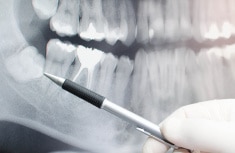 A patient may need an extraction if the following occurs:
A patient may need an extraction if the following occurs:
- Severe decay
- Advanced periodontal disease
- Severe mobility of teeth
- Infection or abscess that cannot be resolved with root canal treatment
- Fractured teeth/roots
- Impacted teeth
- Orthodontic correction
- Wisdom teeth
Some discomfort is to be expected after a tooth is extracted; however, it can be minimized with a painkiller, antibiotics in some cases, and ice packs applied to the face. This discomfort should lessen within two to three days; if it does not lessen or becomes worse, please call our office immediately.
Wisdom Teeth

In some cases, entrapped wisdom teeth can damage the adjacent teeth extensively and need to be extracted. If the patient has enough room for their wisdom teeth, if they are healthy and do not cause damage to the adjacent teeth, wisdom teeth can be left in the mouth. The dentist will evaluate the tooth with an X-ray and determine if the tooth should be extracted. Local anesthetic is routinely used during extraction; nitrous oxide and minimal sedation are available upon request.

